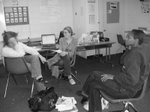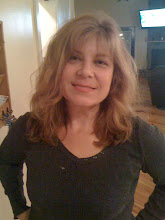Sunday, November 21, 2004
What does it mean to be “colorblind?"
"Visionary Leadership” article
This article defined 3 different kinds of leadership: ordinary leaders-tell cultures, traditional-stories, innovative-take neglected visionary leaders-create new stories.
Take mission statement-mission is linked to vision, will become self-directed learners. Mission is your goal.
Vision statement-vision is linked to big picture, but it will also tell you how things will happen. Vision tells how things will get to mission. Vision-attracts commitment, hand into future and leader is facilitative to develop a collective vision. Negotations a shared vision by challenging, communicating, and empowering. Leaders embody the vision in thought, word, and deed. Cannot be all up in your head, but also trained with techniques.
Shared Values Activity
Guest speaker-Judi Jameson
She had us do an activity with our shared values. We did a "four corners" approach at the end to agree on the group values.
Processing the Values Process:
We experienced community for just the fact that people were able to express their differences while feeling comfortable to share and all expressing in a respectful manner. Necessary to maintain even though their body is doing something different. Through other people’s experiences, you understand yourself. From day one, we were all felt community. Then again, we aren’t community. There are opinions that are repressed, and I can feel it. We are a community in waiting. We are revisiting some old wounds born in the family. And we needed it and were so ready for it.
This discussion is helping to form an indigineous culture. We are native to humans and we are going back to our root of humanity.
We are powerful because we have so many perspectives. We have so many differences and challenges. We need to give kudos and props to everyone because we are very diverse and coming from different hierarchies of education.
OUR GROUP VALUES:
- Trust
- Openness
- Respect
- Commitment
- Flexibility
- Practical Application/Integration
- Diversity
- Accountability
- Creativity
- Integrity
- Compromise
- Collaboration
Saturday, November 20, 2004
Teaching with the Brain in Mind
Left-sequential-more active with positive emotions.
Right-recognizes negative emotions
Occipital-back=vision
Frontal-forehead=judgement creativity, problems, solving, planning
Parietal-top back = processing higher sesory and language
Temporal=ears-earing, memory, meaning and language
Learing Food for brain-water, good diet, oxygen
Stimulation-new doing something
Lasting learning-cell requires less input from another the next time its activitated. Parially gene controlled.(LTP) long-term potentiation-cell is stimulated over and over so that it excites nearby cells(LTD) long-term depression-occurs when synapse is altered so its less likely to firelearning is done through alteration of synaptic activity Behavior-governed by complex emotional states and memories
More about using constructivist principles
- Pose relevant problems for learners
- Structure and build learning around primary concepts.
- Seek and value others’ points of view..and grow from there.
- Adapt curriculum to seek out and address the learners’ suppositions.
- Assess learning in the context of the teaching and learning.
The theory that new knowledge is an active product of the learner integrating new information and perceptions with prior knowledge. It is based on the work of John Dewey, Jean Piaget, and Lev Vygotsky, and complementary with interactivism. Educational theories based on constructivist ideas stand in contrast with behaviorist teaching techniques, such as Direct Instruction.
Our Group Values
Trust
Openness
Respect
Commitment
Flexibility
Practical Application/Integration
Diversity
Accountability
Creativity
Integrity
Compromise
Collaboration
Tao of Personal Leadership - Book Review - Mike
Respect-lifelong learner-dealing with stress-getting your ego out of the leadership-my worth is not my job
Who Will Save Our Schools
ordinary leaders-tell cultures traditional stories
innovative-take neglected
visionary leaders-create new stories
Take mission statement-mission is linked to vision, will become self-directed learners
Vision statement-vision is linked to big picture, but it will also tell you how things will happen. Mission is your goal. Vision tells how things will get to mission.
Vision-attracts commitment, hand into future and leader is facilitative to develop a collective vision. Negotations a shared vision. By challenging, communicating, and empowering. Leaders embodies the vision in thought, word, and deed. Cannot be all up in your head, but also trained with techniques.
Saturday, November 06, 2004
How did I use the constructivist principles during the last 2 weeks?
Verbs, describing words, etc.
Accepting different perspective-how student will relate, how teacher would relate and how I need to accept it.
Doing the Kathy—stepping back.
Call the teacher—facilitator and students—learners.
Whole to part-part to whole-modeling
Asked ?s in circle.
Important to have training with students on how to have discussions—being respectful of each other and not to take things personally.
Facilitator vs. Trainer
- Give information and skill
- Direct learning
- Operate from specified outcomes
- Have an established timeframe
- Plan the sequence to achieve the outcomes
- Are cognitive
- Use an a priori design
- Move from known to known
Facilitator-
- Provide nurturance
- Guide interaction
- Operate from an overarching goal and a vision of possibilities
- Have an undetermined timeframe
- Have a repertoire to draw from, but no predetermined plan
- Are intuitive
- Use an in media res design
- Move from known to unknown
Facilitators must act upon these beliefs:
Must trust the group’s ability to find its own direction and resolution
- ask questions and listen
- recognize that when it’s time, it’s time
Create a form from group work
- model attitudes and behavior
- reveal their thinking
- foster independence
- stay in the here and now
- trust their intuition
Has no preconceived notions
- go slowly to go fast
- use the energy
- if unsure what to do, do nothing

